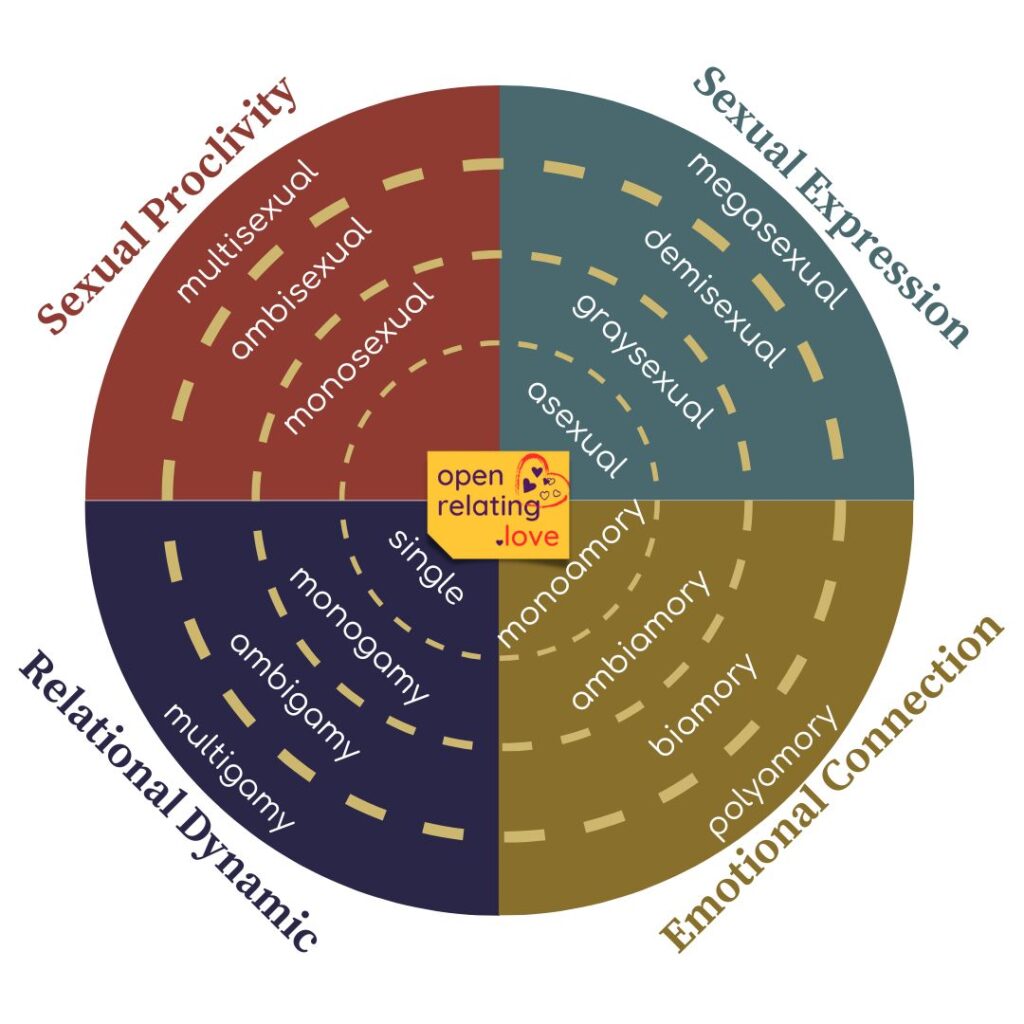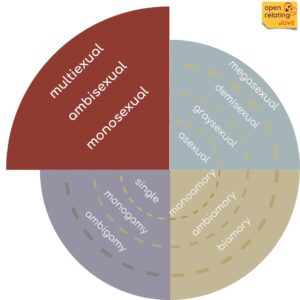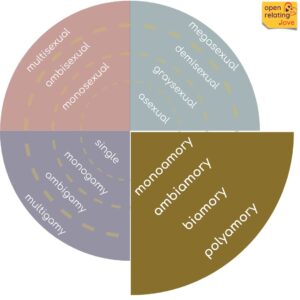The notion that people should just accept the socially normalised, traditional and restrictive way of relating and connecting romantically / sexually seems to me absurd. Just as absurd as it now is to expect everyone to be straight, just because this is how the majority identify, or to insist that people born left-handed must only use their right hand.
Labels are not always necessary, of course. But to some, labels are an important way of coming to terms with who they authentically are, in the face of judgment and discrimination. What matters in my opinion, is how can we think of ourselves to allow our fullest self to unapologetically and proudly emerge. It does not even matter if a certain way of expressing yourself is a born orientation or a lifestyle choice you have made that makes your life happier, more fulfilling and better. What if we accept that all people can find themselves somewhere on a wide spectra of sexuality, orientation, gender, capacity for, and expression of connection?
The spectrum of sexual attraction is well known and not disputed except in extremely religious and conservative societies. This spectrum includes orientations like heterosexual, homosexual, bisexual and pansexual but is not limited to just these labels. I propose that we also look at spectra that can helps us find a compatible label (if we are seeking labels for ourselves).
These spectra show that there is no default way of being and definitely that nothing is binary. The definitions I am using may not reflect definitions that exist in other resources. In some cases I needed to come up with my own terms where no suitable existing labels could be found. They are also not exhaustive. There are many other terms and descriptors currently in use around the world. Please feel free to provide your own, if different, in the comments.
- Sexual proclivity spectrum: The variety of sexual partners that we enjoy connecting with
- Sexual expression spectrum: How we tend to connect sexually (if at all) with others
- Emotional connection spectrum: How we emotionally connect with others
- Relational dynamic spectrum: The kind of relationship format that best suits us

The graphic representation of these spectra is a simplified illustration of the concept. Some of the terms used are well known in popular media but are sometimes used interchangeably or contrasting with non-related terms. In some cases, I am using a term that is not in popular use because I could not find this already laid out in a way that made sense to me. This all started because I felt frustrated that people kept contrasting monogamy (a relationship model that is popular and widely seen as the default relationship dynamic), with polyamory (a way of connect emotionally with other people). They really are not comparable and belong in different spectrums.
Sexual Proclivity
The variety of sexual partners that we enjoy connecting with

There isn’t a ‘natural’ or ‘default’ way of expressing sexual interest. It varies according to both biological and learned needs and wants. Some find that focusing on one sexual partner is more than enough while others enjoy and find pleasure in variety and diversity with multiple sexual partners.
While this is not true for all, some feel that having a label that defines proclivity for sexual partners is helpful to accept who they are and to explain it to others. This can be permanent or may shift, change, ebb and flow over time, depending on the phase of life, mood or health, and the relationship dynamic. This spectrum may not fit your view of yourself, which is totally fine.
(I identify as multisexual since I am interested in, and actively engage in physical/sexual interactions with multiple partners. In my case, it is compatible with my other identities – being polyamorous, multigamous and megasexual.)
- Monosexual: Someone who is only interested to have at most, one sexual partner at any given time.
- Ambisexual: Where the addition of more than one sexual partner is relationship/situation dependent.
- Multisexual*: Interested to explore sexual activity with multiple partners.
*Not a term I have seen anyone else use
Sexual Expression
How we tend to connect sexually (if at all) with others

How people express their sexuality and connect sexually to others can vary greatly along the spectrum. This can come from innate personality, prior experience as well as from trauma.
These terms are not the only ones, only some touch points along the spectrum. Your life experience, way of creating bonds etc. will all have an impact. You may also find that with some people, your sexual expression can be different than with others.
- Asexual: Someone that feels little or no sexual urges, lacks desire to engage in sexual activity. Everyone has a different experience of being asexual, and this can mean different things to different people.
- Graysexual: Largely asexual but with some interest in sexual activity, seldom and only with specific people
- Demisexual: Someone who only feels a sexual connection with a person that they have an emotional bond with first.
- Megasexual: sexual connection comes before and often is needed in order to have an emotional one. The path to building emotional intimacy often starts with a sexual attraction and connection.
Emotional Connection
How we emotionally connect with others

Most people who default to a monogamous relationship dynamic never stop to consider their emotional capacity for connecting to others. Emotional connection is about your capability/capacity to hold romantic/sexual or other kinds of non-family love and express it. This is different from the relationship model or dynamic that you choose to practice.
Amore=love
- Monoamory: When love is focused on one person only. A monoamorous person feels fulfilled emotionally from connecting to one person.
- Ambiamory: Describes an emotional connection to either one person, or more than one. It can change with the relationship dynamic chosen or your current state of mind. People who experience ambiamory can feel happy and fulfilled in both monogamous and multigamous relationships, depending on the agreement they have with a partner.
- Biamory: An emotional capacity that is limited to loving only people at the same time. For example, some people who are bisexual or pansexual would truly feel fulfilled only if they were emotionally committed to people of 2 different genders.
- Polyamory: The capacity to love multiple people at the same time, express that love and accept that love is not a finite resource.
Relational Dynamic
The kind of relationship format that best suits us

The way a relationship with others is structured falls along a spectrum as well. Knowing that all options are equally valid means you can design a relationship that matches your emotional and sexual connection style. If you identify with one or more of the previous emotional connection types, sexual proclivity and expression styles, then it can navigate you towards selecting a particular relationship dynamic. However, other factors go into this selection, not all of them conscious. These include: The dynamic that your parents modelled for you (positively or negatively); popular media impressions; time constraints due to family or work responsibilities; past traumatic relationships; anxious or avoidant styles of connecting with intimate partners; your love languages and more.
- Singledom: A conscious choice to only be in a relationship with self. People think of being single as something to avoid at all costs. At some phases of our lives, staying single is helpful and empowering. Some choose it to keep their lives simple and only be responsible for their own needs. People who choose single can still experience emotional and sexual connection along the previous spectra.
- Monogamy: A relationship dynamic where the choice of two people is to focus their energy and attention exclusively on one another. There is sometimes a blurred line between monogamy and Multigamy for people who are not actually monoamorous, but have struggled to communicate their needs to themselves and their partner. This might look like drunkenly kissing others at a party, struggling to align their deep emotional bonds to close friends with the emotional exclusivity needs of their partner, or concealing their affairs and pretending they are happy with monogamy. Cheating is not necessarily about the dissonance between relationship dynamic and connection style, but it can be.
- Ambigamy: Someone who is secure in their emotional place may have no strong preference to the relationship dynamic. It can depend on the partner or the situation they are in. A monoamorous person might accept being in a multigamous relationship with a polyamorous partner, where only the polyamorous partner sees other people. Or an ambiamorous person may willingly accept to be in monogamy if they are in-love with a monoamorous person.
- Multigamy: Usually referred to as non-monogamy, often pre-ambled with ‘ethical’ or ‘consensual’, it is a relationship dynamic that includes more than two people. It is a conscious choice to spend time and energy on multiple partners.
It is helpful to know where you are on each of these spectra, knowing that it is fluid and could change. I find it helpful to work out why I identify with certain definitions and terms more than others. It feels incredibly powerful to know how to communicate this clearly and emphatically to potential intimate partners, friends and family.
You can download a PDF version of the spectra wheel, where you can trace your own identities and preferences as a handy way of exploring yourself and sharing with others.
If you find that it is something that may be tricky do accomplish alone, there are ways that I can offer support and guidance. You could schedule a call with me, join a peer support session or watch one of my recorded webinars. If you are not sure, just message me through the contact form and I will be in touch.
-
 Coaching – for individuals£110
Coaching – for individuals£110 -
 Counselling£90
Counselling£90 -
 Access All Content Pass£29
Access All Content Pass£29








[…] Have you heard of the term Ambiamourous? It sounds like it kind of describes you. You go for what feels right, depending on the dynamic you […]
[…] then a multigamous (non-monogamous) relationship is the evolved choice for them. If someone is monoamorous, then monogamy is the evolved relationship model for […]
[…] can look like many things. It doesn’t even mean those involved are polyamorous. They may be monoamorous & polysexual for […]
[…] tendency towards multiple loves whereas others are happy with loving a single person. It can be a spectrum as much as gender and attraction are […]
[…] Read more in this article […]